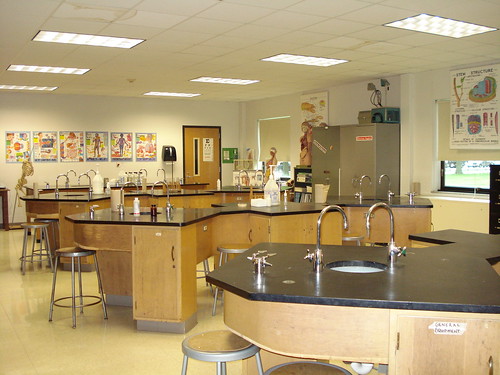Classrooms as ecosystems: The physical environment
By Mary Bigelow
Posted on 2015-06-23
(This is a continuation of Classrooms as ecosystems: Social interactions, in response to a question about creating a classroom that is a positive place for learning:
 The physical environment
The physical environment
When I taught a graduate education class, I asked my students to provide visual tours of their classrooms with photographs and descriptions explaining why the room was organized the way it was: why the desks or tables were configured the way they were, what was on the bulletin boards and why, how materials were stored, where the teacher’s desk was positioned and why, and their wish lists on how the space could be improved. (I modeled the activity with my own classroom). This led to an interesting discussion on physical factors that affect learning and the types of activities that teachers and the students can do. This of course varies by age and subject area; an elementary classroom has different characteristics than a secondary science lab.
In general, you’ll want your classroom/lab to be physically conducive to learning: safe, comfortable, flexible, and attractive. Students should know that this is a science space (whether it’s an entire classroom or a science corner), with appropriate materials and organization.
Safe: Your classroom/lab should have appropriate safety features, running water, electrical outlets, and flat tables. If you’re teaching science in a regular classroom without these, you and the students are limited in what you can do. If an activity or investigation cannot be done safely, you can’t do it, regardless of how interesting it might be. (See the blog Lab Safety Question)
If you’re a floater (unfortunately a common assignment for new teachers), it’s very hard to get a sense of place with students. Every room will be different, and the teacher based there may be territorial enough to limit what you can do (Don’t write on the board, don’t use the projector, don’t move the desks, etc.). This situation requires planning and cooperation among teachers and administrators to ensure that all students have equitable opportunities in an appropriate facility.
Another aspect of safety is the amount of clutter. (We teachers are often pack rats; we never know when we’ll need something!) Storage space in classrooms and labs is often at a premium. But without a plan for organizing and storing materials, classrooms can become overwhelmed with stuff and become fire hazards, dust collections, and barriers to student movement and exits. The clutter is also distracting to students.
Comfortable: There should be enough flat-topped desks or chairs and tables for students to work. Students should have room to move around and spread out. Desks and lab tables should be the appropriate size for the students (this is sometimes a problem in middle schools that are repurposed high schools). The lighting should be adequate, especially in rooms where there are no windows.
Flexible: We’ve all seen pictures of schoolrooms with student desks bolted to the floor. While this might be a custodian’s dream come true, it’s not necessarily appropriate for a variety of learning activities. No one seating arrangement is best—each has advantages and disadvantages, depending on the learning activities. If you use a variety of instructional strategies in your class, you’ll want to use a variety of seating arrangements. (See the blog Classroom Seating Arrangements.)
Attractive: If there were a “Classroom Beautiful” magazine, I’m sure there would be many nominees for the cover. Many teachers spend hours each year planning and creating colorful bulletin boards. But what about student input? The classroom should belong to the students rather than serve as a shrine to the teacher’s interests or artistic abilities. (See the blog Displaying Science on Classroom Bulletin Boards and The Classroom as Learning Center.)
It is possible to have an attractive classroom that does not require much time or expense. You can set up a table with materials related to your current topics for students to examine (e.g., shell collections, animal bones, rock samples, weather maps, simple machines). Hand lenses and microscopes invite students to explore. A display of science trade books can brighten up a corner and encourage students to browse and learn.
Another component of an attractive classroom is organization—a place for everything and everything in its place. Having designated places for materials and de-cluttering is easier said than done in a classroom, but students can be part of this endeavor.
I’m sure your cooperating teacher works hard at creating and adjusting an effective and efficient learning environment. With careful planning, organization, monitoring, and reflective feedback, your new classroom ecosystem can facilitate learning as a joyous, exciting adventure.
Disclaimer: The views expressed in this blog post are those of the author(s) and do not necessarily reflect the official position of the National Science Teaching Association (NSTA).


